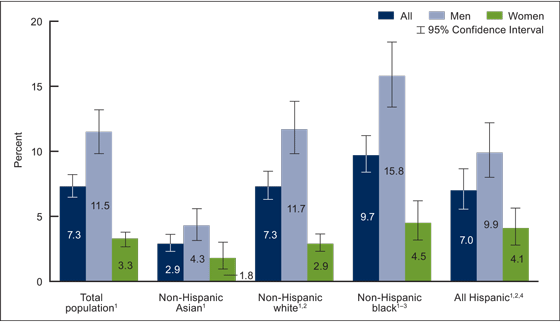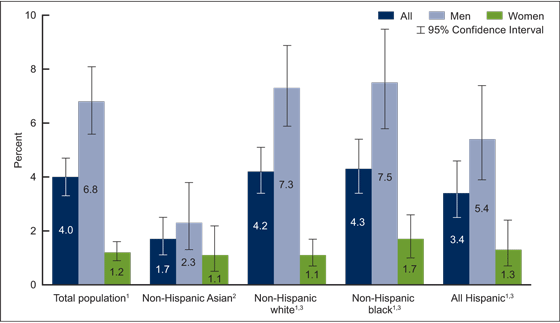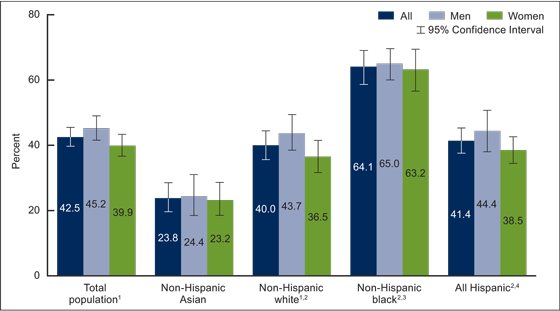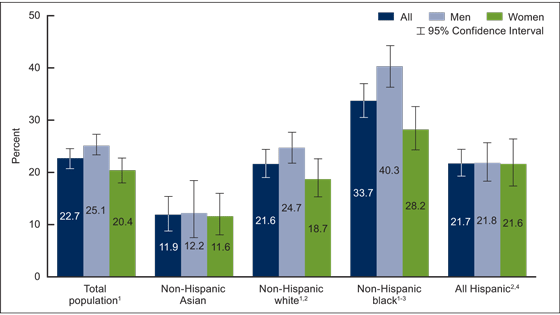Prevalence of HPV in Adults Aged 18–69: United States, 2011–2014
On This Page
- Key findings
- Prevalence of any oral HPV was lowest among non-Hispanic Asian adults and highest among non-Hispanic black adults.
- Prevalence of high-risk oral HPV was lower among non-Hispanic Asian adults compared with other race and Hispanic groups.
- Prevalence of any genital HPV was lowest among non-Hispanic Asian adults and highest among non-Hispanic black adults.
- Prevalence of high-risk genital HPV was lowest among non-Hispanic Asian adults and highest among non-Hispanic black adults.
- Summary
- Definitions
- Data source and methods
- About the authors
- References
- Suggested citation
NCHS Data Brief No. 280, April 2017
PDF Version (352 KB)
Geraldine McQuillan, Ph.D., Deanna Kruszon-Moran, M.S., Lauri E. Markowitz, M.D., Elizabeth R. Unger, M.D., Ph.D., and Ryne Paulose-Ram, Ph.D., M.A.
Key findings
Data from the National Health and Nutrition Examination Survey
- During 2011–2014, prevalence of any oral human papillomavirus (HPV) for adults aged 18–69 was 7.3%; high-risk HPV was 4.0%.
- Overall, prevalence of any and high-risk oral HPV was lowest among non-Hispanic Asian adults; any oral HPV was highest among non-Hispanic black adults.
- Prevalence of any and high-risk oral HPV was higher in men than women except for high-risk HPV among Asian adults.
- During 2013–2014, prevalence of any and high-risk genital HPV for adults aged 18–59 was 45.2% and 25.1% in men and 39.9% and 20.4% in women, respectively.
- Prevalence of any and high-risk genital HPV was lower among non-Hispanic Asian and higher among non-Hispanic black than both non-Hispanic white and Hispanic men and women.
Human papillomavirus (HPV) is the most common sexually transmitted infection in the United States (1). Some HPV types can cause genital warts and are considered low risk, with a small chance for causing cancer. Other types are considered high risk, causing cancer in different areas of the body including the cervix and vagina in women, penis in men, and anus and oropharynx in both men and women (2). This report provides the most recent national estimates of oral HPV prevalence among adults aged 18–69 from the National Health and Nutrition Examination Survey (NHANES) 2011–2014, as well as prevalence of genital HPV among adults aged 18–59 from NHANES 2013–2014. Estimates of any HPV (37 types tested) as well as high-risk HPV (14 of the 37 types) are provided.
Keywords: human papillomavirus, NHANES
Prevalence of any oral HPV was lowest among non-Hispanic Asian adults and highest among non-Hispanic black adults.
- During 2011–2014, prevalence of any oral HPV was 7.3% among adults aged 18–69, 11.5% among men and 3.3% among women (Figure 1).
- Prevalence of any oral HPV was lower among non-Hispanic Asian adults (2.9%) and higher among non-Hispanic black adults (9.7%) compared with both non-Hispanic white (7.3%) and Hispanic adults (7.0%). For men, there was a similar racial and ethnic pattern.
- Prevalence of any oral HPV was lowest among non-Hispanic Asian women. No significant difference in prevalence was seen among non-Hispanic white, non-Hispanic black, and Hispanic women.
- Men had a higher prevalence of oral HPV than women, overall and within each race and Hispanic group.
Figure 1. Prevalence of any oral HPV among adults aged 18–69, by race and Hispanic origin and sex: United States, 2011–2014.
1Percentage for men is significantly different from women.
2Percentage is significantly different from non-Hispanic Asian adults, all, men, and women.
3Percentage is significantly different from non-Hispanic white adults, all and men.
4Percentage is significantly different from non-Hispanic black adults, all and men.
NOTES: HPV is human papillomavirus. Any oral HPV means tested positive to one or more of the 37 HPV types from an oral rinse sample.
Access data table for Figure 1.
SOURCE: NCHS, National Health and Nutrition Examination Survey, 2011–2014.
Prevalence of high-risk oral HPV was lower among non-Hispanic Asian adults compared with other race and Hispanic groups.
- During 2011–2014, prevalence of high-risk oral HPV was 4.0% among adults aged 18–69, 6.8% among men and 1.2% among women (Figure 2).
- Prevalence was lower among non-Hispanic Asian adults, overall (1.7%) and among men (2.3%), than non-Hispanic white (4.2% all, 7.3% men), non-Hispanic black (4.3% all, 7.5% men), and Hispanic (3.4% all, 5.4% men) adults.
- No differences were seen in prevalence of high-risk oral HPV by race and Hispanic group among women (1.1%–1.7%).
- Prevalence of high-risk oral HPV was higher among men than women in all race and Hispanic groups, although the difference was not significant among non-Hispanic Asian adults.
Figure 2. Prevalence of high-risk oral HPV among adults aged 18–69, by race and Hispanic origin and sex: United States, 2011–2014
1Percentage of men is significantly different from women.
2Percentage estimate for non-Hispanic Asian women may be unreliable because it is based on 6 positive samples and has a relative standard error greater than 30% but less than 40%.
3Percentage is significantly different from non-Hispanic Asian adults, all and men.
NOTES: HPV is human papillomavirus. High-risk oral HPV means tested positive to one or more of the 14 high-risk HPV types (16, 18, 31, 33, 35, 39, 45, 51, 52, 56, 58, 59, 66, or 68) from an oral rinse sample. Access data table for Figure 2.
SOURCE: NCHS, National Health and Nutrition Examination Survey, 2011–2014.
Prevalence of any genital HPV was lowest among non-Hispanic Asian adults and highest among non-Hispanic black adults.
- During 2013–2014, prevalence of any genital HPV was 42.5% among adults aged 18–59, 45.2% among men and 39.9% among women (Figure 3).
- Overall, and for both men and women, prevalence of any genital HPV was lowest among non-Hispanic Asian adults and highest among non-Hispanic black adults, with no significant difference in prevalence between non-Hispanic white and Hispanic adults.
- Prevalence of any genital HPV was higher among men than women overall and among non-Hispanic white adults. The pattern was similar for Hispanic adults, but the difference between men and women was not statistically significant.
Figure 3. Prevalence of any genital HPV among adults aged 18–59, by race and Hispanic origin and sex: United States, 2013–2014
1Percentage for men is significantly higher than women.
2Percentage is significantly different from non-Hispanic Asian, all, men, and women.
3Percentage is significantly different from non-Hispanic white, all, men, and women.
4Percentage is significantly different from non-Hispanic black, all, men, and women.
NOTES: HPV is human papillomavirus. Any genital HPV means tested positive to one or more of the 37 HPV types from a penile or vaginal swab sample. Penile samples were available only for 2013–2104, so results presented were limited to that cycle. Access data table for Figure 3.
SOURCE: NCHS, National Health and Nutrition Examination Survey, 2013–2014.
Prevalence of high-risk genital HPV was lowest among non-Hispanic Asian adults and highest among non-Hispanic black adults.
- During 2013–2014, the prevalence of high-risk HPV was 22.7% among adults aged 18–59, 25.1% among men and 20.4% among women (Figure 4).
- Overall, and for both men and women, prevalence of high-risk genital HPV was lowest among non-Hispanic Asian adults and highest among non-Hispanic black adults, with no significant difference in prevalence between non-Hispanic white and Hispanic adults.
- Prevalence of any genital HPV was higher among men than women overall and among non-Hispanic white and non-Hispanic black adults.
Figure 4. Prevalence of high-risk genital HPV among adults aged 18–59, by race and Hispanic origin and sex: United States, 2013–2014
1Percentage for men is significantly higher than women.
2Percentage is significantly different from non-Hispanic Asian, all, men, and women.
3Percentage is significantly different from non-Hispanic white, all, men, and women.
4Percentage is significantly different from non-Hispanic black, all, men, and women.
NOTES: HPV is human papillomavirus. High-risk genital HPV means tested positive to one or more of the 14 high-risk HPV types (16, 18, 31, 33, 35, 39, 45, 51, 52, 56, 58, 59, 66, or 68) from a penile or vaginal swab sample. Penile samples were available only for 2013–2014, so all results presented were limited to that cycle. Access data table for Figure 4.
SOURCE: NCHS, National Health and Nutrition Examination Survey, 2013–2014.
Summary
During 2011–2014, prevalence of any oral HPV among adults aged 18–69 was 7.3% and high-risk oral HPV was 4.0%. Prevalence of any and high-risk oral HPV was lowest among non-Hispanic Asian adults and any oral HPV was highest among non-Hispanic black adults. Prevalence of high-risk oral HPV was significantly higher in men than women in every race and Hispanic group except non-Hispanic Asian adults. The higher prevalence in men than women was also reported in a previous NHANES study, 2009–2010 (3).
During 2013–2014, any genital HPV prevalence among adults aged 18–59, was 42.5% in the total population, 45.2% among men and 39.9% among women; high-risk genital HPV prevalence was 22.7% in the total population, 25.1% among men and 20.4% among women. Non-Hispanic Asian adults had the lowest prevalence of any and high-risk genital HPV among the total population as well as among men and women. In contrast, non-Hispanic black adults had the highest prevalence of any and high-risk genital HPV among the total population and among men and women. Prevalence was also higher among men than women for both any and high-risk genital HPV in the total population and among non-Hispanic white adults.
This report provides the latest estimates of HPV prevalence, examining both oral and genital sites, by sex and race and Hispanic group. NHANES does not include populations that may be considered at higher risk for HPV (i.e., those institutionalized, incarcerated, in nonhospital-based long-term care facilities, injection-drug using, and homeless, among others). Therefore, these data provide conservative estimates of both oral and genital HPV among U.S. adults. Other recent reports of HPV prevalence from NHANES have examined the impact of the U.S. HPV vaccination program on HPV prevalence among women (4) and the first data on HPV prevalence among men (5).
Definitions
Any oral HPV: Oral rinse sample tested positive to one or more of the 37 HPV types listed under “All HPV types.”
High-risk oral HPV: Oral rinse sample tested positive to one or more of 14 high-risk HPV types (see definition) out of the 37 HPV types.
Any genital HPV in women: Vaginal swab sample tested positive to one or more of the 37 HPV types listed under “All HPV types.”
High-risk genital HPV in women: Vaginal swab sample tested positive to one or more of the 14 high-risk HPV types (see definition) out of the 37 HPV types.
Any genital HPV in men: Penile swab sample tested positive to one or more of the 37 HPV types listed under “All HPV types.”
High-risk genital HPV in men: Penile swab sample tested positive to one or more of the 14 high-risk HPV types (see definition) out of the 37 HPV types.
All HPV types (includes types detected by L1 consensus polymerase chain reaction): 6, 11, 16, 18, 26, 31, 33, 35, 39, 40, 42, 45, 51, 52, 53, 54, 55, 56, 58, 59, 61, 62, 64, 66, 67, 68, 69, 70, 71, 72, 73, 81, 82, 83, 84, 89, or IS39.
High-risk HPV types: 16, 18, 31, 33, 35, 39, 45, 51, 52, 56, 58, 59, 66, or 68.
Data source and methods
Data from NHANES 2011–2014 were used for these analyses. NHANES is a cross-sectional survey designed to monitor the health and nutritional status of the civilian noninstitutionalized U.S. population. The survey consists of interviews conducted in participants’ homes followed by standardized physical examinations that include collections of various biological specimens for laboratory tests.
NHANES is based on a complex, multistage design with data released in two-year cycles. The design includes oversampling and the ability to combine cycles to obtain reliable estimates for population subgroups. Starting with the 2011–2012 survey cycle, non-Hispanic Asian persons were oversampled to obtain more reliable estimates of health on this racial and ethnic group. Oral HPV data were available for adults aged 18–69 during NHANES 2011–2014. Genital HPV data were available for women aged 18–59 during 2011–2014 but among men only during 2013–2014. For consistency, only genital data from 2013–2014 are presented for both men and women. Additional information about NHANES can be found on its website: https://www.cdc.gov/nchs/nhanes/.
Prevalence estimates and standard errors were calculated in SAS-callable SUDAAN software version 11.0 (RTI International, Research Triangle Park, N.C). The examination sample weights were used to account for differing probabilities of selection, nonresponse, and noncoverage. Taylor series linearization was used to calculate standard errors to take into account the complex sampling design. Differences between groups were evaluated using a Student’s t statistic at the p < 0.05 significance level. Estimates with a relative standard error greater than 30% or based on less than 10 positives were designated as potentially unreliable and should be interpreted with caution. All differences discussed were statistically significant unless otherwise indicated. Calculated estimates were not age-adjusted, and no adjustments were made for multiple comparisons.
About the authors
Geraldine McQuillan, Deanna Kruszon-Moran, and Ryne Paulose-Ram are with the National Center for Health Statistics, Division of Health and Nutrition Examination Surveys. Lauri E. Markowitz is with the National Center for Immunization and Respiratory Diseases, Division of Viral Diseases. Elizabeth R. Unger is with the National Center for Emerging and Zoonotic Infectious Diseases, Division of High-Consequence Pathogens and Pathology.
References
- Satterwhite CL, Torrone E, Meites E, Dunne EF, Mahajan R, Ocfemia MC, et al. Sexually transmitted infections among US women and men: Prevalence and incidence estimates, 2008. Sex Transm Dis 40(3):187–93. 2013.
- Viens LJ, Henley SJ, Watson M, et al. Human papillomavirus-associated cancers—United States, 2008–2012. MMWR Morb Mortal Wkly Rep 65(26):661–6. 2016.
- Gillison ML, Broutian T, Pickard RK, Tong ZY, Xiao W, Kahle L, et al. Prevalence of oral HPV infection in the United States, 2009–2010. JAMA 307(7):693–703. 2012.
- Markowitz LE, Liu G, Hariri S, Steinau M, Dunne EF, Unger ER. Prevalence of HPV after introduction of the vaccination program in the United States. Pediatrics 137(3): 2016.
- Gargano JW, Unger ER, Liu G, Steinau M, Meites E, Dunne E, Markowitz LE. Prevalence of genital human papillomavirus in males, United States, 2013–2014. J Infect Dis. 2017.
Suggested citation
McQuillan G, Kruszon-Moran D, Markowitz LE, Unger ER., Paulose-Ram R. Prevalence of HPV in adults aged 18–69: United States, 2011–2014. NCHS data brief, no 280. Hyattsville, MD: National Center for Health Statistics. 2017.
Copyright information
All material appearing in this report is in the public domain and may be reproduced or copied without permission; citation as to source, however, is appreciated.
National Center for Health Statistics
Charles J. Rothwell, M.S., M.B.A., Director
Jennifer H. Madans, Ph.D., Associate Director for Science
Division of Health and Nutrition Examination Surveys
Kathryn S. Porter, M.D., M.S., Director
Ryne Paulose-Ram, Ph.D., Associate Director for Science
- Page last reviewed: April 6, 2017
- Page last updated: April 6, 2017
- Content source:


 ShareCompartir
ShareCompartir



